
PUMPA - SMART LEARNING
எங்கள் ஆசிரியர்களுடன் 1-ஆன்-1 ஆலோசனை நேரத்தைப் பெறுங்கள். டாப்பர் ஆவதற்கு நாங்கள் பயிற்சி அளிப்போம்
Book Free DemoWomen were not supposed to come out of their houses during ancient days. If they need to go anywhere, they must travel with their parents or guardians. Women did not have the freedom to do anything they wanted. They were not permitted to pursue education. They were grown-up to do household chores, take care of their husbands, and give birth to children.
The lesson "Empowered Woman Navigating the World" portrays that women in India who stayed indoors were gone. The days when women were sent out with a guardian were gone. Everything has changed because women fought for their liberation and set a good example for other women. Even though women were treated as slaves, some attempted to break free by pursuing education during ancient times. Though women's real power and victories were recognised earlier, there was no advanced technology to showcase their talents. Their skills were later projected globally as technology and media advanced. Technology and media bring to light the excellent deeds of women all around India.
After the help of technological advancements, people came to know that women occupied most of the positions in society. For instance, nowadays, women are playing their roles as teachers, doctors, astronauts, scientists, engineers, etc. Their accomplishments were in every field. One of the most prominent examples and achievements of woman empowerment was the "All-women Indian Navy crew". The women of the Indian Navy crew travelled around the world alone on a sailboat called INSV Tarini for 254 days.
The lesson "Empowered Woman Navigating the World" portrays that women in India who stayed indoors were gone. The days when women were sent out with a guardian were gone. Everything has changed because women fought for their liberation and set a good example for other women. Even though women were treated as slaves, some attempted to break free by pursuing education during ancient times. Though women's real power and victories were recognised earlier, there was no advanced technology to showcase their talents. Their skills were later projected globally as technology and media advanced. Technology and media bring to light the excellent deeds of women all around India.
After the help of technological advancements, people came to know that women occupied most of the positions in society. For instance, nowadays, women are playing their roles as teachers, doctors, astronauts, scientists, engineers, etc. Their accomplishments were in every field. One of the most prominent examples and achievements of woman empowerment was the "All-women Indian Navy crew". The women of the Indian Navy crew travelled around the world alone on a sailboat called INSV Tarini for 254 days.

Women as teacher, scientist, doctor and astronaut
The All-India Women's crew travelled across the world in INSV Tarini, and there remained a question, "What is INSV Tarini?" INSV is an acronym that stands for Indian Naval Ship Vessel. It was a 55-foot sailboat. The boat was designed in Goa by M/s Aquarius Shipyard Pvt Ltd, and it was entirely constructed in India. 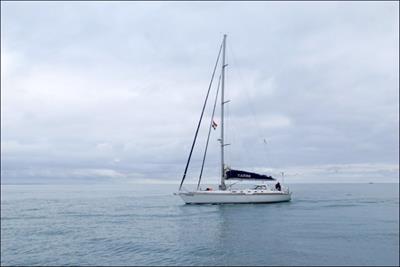
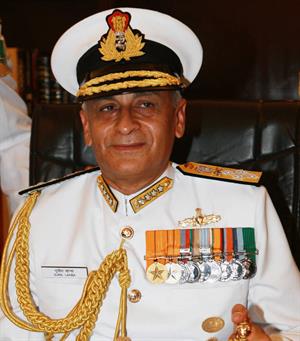
Admiral Sunil Lanba*
The foremost goal of the expedition was to showcase the 'Make in India' effort by travelling onboard the INSV Tarini, which was built entirely in India. This sailboat was notable for encouraging the use of environmentally friendly non-conventional renewable energy sources such as wind; collecting and updating meteorological, ocean, and wave data regularly for accurate weather forecasting by the India Meteorological Department (IMD); and collecting data for monitoring marine pollution on the high seas.
The Indian Navy had a crew of six people. The Indian Navy's all-women crew was the first to circumnavigate the globe, and Lt. Commander Vartika Joshi led the team. The team also had other five women crew embers. They were Lt. Cdr. Pratibh Jamwal, Lt. Cdr. Swathi Patarapalli, Lt. Aishwarya Boddapati, Lt. Sh. Vijaya Devi and Lt. Payal Gupta. 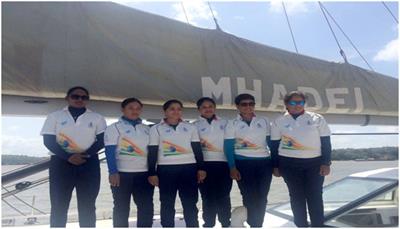 Indian Navy’s Six Women Crew*
Indian Navy’s Six Women Crew*
The Indian Navy's all-women crew set sail from Goa on September 10, 2017. It was carried out with the approval of India's Defence Minister. It was a momentous occasion in navigational history that would be recognised around the world. The journey was divided into five stages. This sailboat stops at four different ports.
The ports where the sailboat stops were Fremantle (Australia), Lyttleton (New Zealand), Port Stanley (Falkland Islands) and Cape Town (South Africa). The primary purpose of stopping the sailboat in these places was to refill the food requirements and check the boat's maintenance whenever needed. The crew hoped that they would return to Goa in April 2018. But the all Indian woman travelled around the world in 254 days and arrived in Goa port on May 21, 2018. During their world-record-breaking sail, the six-member of the women crew broke out many stereotypes.

INSV Tarini*
The boat was named after the well-known 'Tara-Tarini' temple in Odisha's Ganjam district. Tarini is a word that means "boat" in English and "Saviour" in Sanskrit. Before starting their journey, the sailors on the ship would pray to the goddess Tara-Tarini. They believed that they would be safe and successful if they worshipped the deity before setting sail. INSV Tarini is the Indian Navy's second sailboat, and the first sailboat was INSV Mhadei (a sail training boat of the Indian Navy). On February 18, 2017, INSV Tarini was designated into the Indian Navy following various sea trials. Many modern technologies were utilised in the sailboat's construction. It was equipped with a strong Raymarine navigation suite and a satellite communication system array. Raymarine was a leading manufacturer and provider of electronic marine equipment. The innovative technology's foremost purpose was to assist sailors in surviving any type of crisis and travelling anywhere in the world.
In India, a project was launched to promote the Women's Navy Force. The project was called Navika Sagar Parikrama. The major theme of the project was carried out in agreement with national policy. Its goal was to inspire women to attain their greatest potential. Admiral Sunil Lanba, the Chief of Naval Staff, delivered a forceful message in his welcome speech. He claimed that the project's goal was to "promote ocean sailing activities in the Navy while also demonstrating the Government of India's ambition for Nari Shakti (women power)."

Admiral Sunil Lanba*
The foremost goal of the expedition was to showcase the 'Make in India' effort by travelling onboard the INSV Tarini, which was built entirely in India. This sailboat was notable for encouraging the use of environmentally friendly non-conventional renewable energy sources such as wind; collecting and updating meteorological, ocean, and wave data regularly for accurate weather forecasting by the India Meteorological Department (IMD); and collecting data for monitoring marine pollution on the high seas.
The Indian Navy had a crew of six people. The Indian Navy's all-women crew was the first to circumnavigate the globe, and Lt. Commander Vartika Joshi led the team. The team also had other five women crew embers. They were Lt. Cdr. Pratibh Jamwal, Lt. Cdr. Swathi Patarapalli, Lt. Aishwarya Boddapati, Lt. Sh. Vijaya Devi and Lt. Payal Gupta.

The Indian Navy's all-women crew set sail from Goa on September 10, 2017. It was carried out with the approval of India's Defence Minister. It was a momentous occasion in navigational history that would be recognised around the world. The journey was divided into five stages. This sailboat stops at four different ports.
The ports where the sailboat stops were Fremantle (Australia), Lyttleton (New Zealand), Port Stanley (Falkland Islands) and Cape Town (South Africa). The primary purpose of stopping the sailboat in these places was to refill the food requirements and check the boat's maintenance whenever needed. The crew hoped that they would return to Goa in April 2018. But the all Indian woman travelled around the world in 254 days and arrived in Goa port on May 21, 2018. During their world-record-breaking sail, the six-member of the women crew broke out many stereotypes.
When the all-India women's crew arrived in Goa, an interview was held with the crew members. The women crew members who navigated the world in 254 days shared their extraordinary adventure in the interview. Through their interview, people understood the struggles and unanticipated hurdles the crew members faced throughout their journey.
An interviewer then inquired how familiar they were with the sailboat before starting the work. Vartika Joshi (the leader of the All India women crew) responded by saying that none of them had ever seen a sailboat or an ocean-going vessel. Furthermore, she added that none of them had ever sailed before, and female officers were not permitted to operate on combat platforms. The Naval Combat Management System is a software-intensive system that must be adjustable to function in a complicated naval fighting situation. She also mentioned that transporting the boat from one spot to another at sea was difficult. Vartika further mentioned that after three years of training, they improved on it steadily.
After hearing Vartika Joshi's response, the interviewer asked her to clarify their training before starting the expedition. Vartika went on to say that they began with theoretical courses in navigation, communication, and weather forecasting. She stated that classroom classes were not the same as sailing outside in a boat. Furthermore, she stated that students were given practical courses such as repairing objects and coping with emergency situations. She also added that they had provided special training for dealing with weather changes, helping a person in a medical emergency, and escaping from the situation.
An interviewer then inquired how familiar they were with the sailboat before starting the work. Vartika Joshi (the leader of the All India women crew) responded by saying that none of them had ever seen a sailboat or an ocean-going vessel. Furthermore, she added that none of them had ever sailed before, and female officers were not permitted to operate on combat platforms. The Naval Combat Management System is a software-intensive system that must be adjustable to function in a complicated naval fighting situation. She also mentioned that transporting the boat from one spot to another at sea was difficult. Vartika further mentioned that after three years of training, they improved on it steadily.
After hearing Vartika Joshi's response, the interviewer asked her to clarify their training before starting the expedition. Vartika went on to say that they began with theoretical courses in navigation, communication, and weather forecasting. She stated that classroom classes were not the same as sailing outside in a boat. Furthermore, she stated that students were given practical courses such as repairing objects and coping with emergency situations. She also added that they had provided special training for dealing with weather changes, helping a person in a medical emergency, and escaping from the situation.
After Vartika Joshi completed her training experience, Aishwarya began to narrate the remaining events of the expedition. Aishwarya added that they went through the basic sail training course in Mumbai. The training took place at the Indian Naval Watermanship Training Centre (INWTC) and several schools in Kochi's southern naval facility. She also stated that they sailed on INSV Mhadei to Mauritius from 2016-2017 and Cape Town in December 2016.
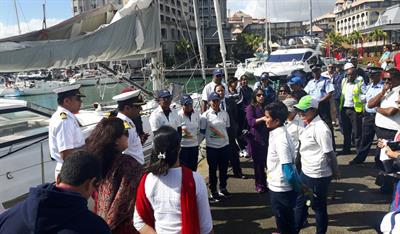
All-women crew sails into Port Louis, Mauritius on INSV Mhadei*
In addition, Aishwarya stated that the Indian women crew members spent over three years in training to prepare for the expedition. As they travelled in the old boat, it had minor leaks and repairs. Also, they underwent lack of water and food. Through this training, they learned how to manage food, water, and even electricity during the big journey.
The interviewer then asked them how was the selection process and how they got selected in the particular field. After hearing that, Aishwarya stated that thirty women applied for the same position. Out of thirty women, the six members were shortlisted for the position. They were shortlisted based on the survival skill they showcased during their training. The crew was mentored by Commander Dilip Donde. He was the first Indian solo captain who travelled worldwide in an India-built sailboat INSV from August 19, 2009 to May 19, 2010. After hearing about the violence or outburst at sea, Aishwarya thought about joining the team.
The interviewer then asked them how was the selection process and how they got selected in the particular field. After hearing that, Aishwarya stated that thirty women applied for the same position. Out of thirty women, the six members were shortlisted for the position. They were shortlisted based on the survival skill they showcased during their training. The crew was mentored by Commander Dilip Donde. He was the first Indian solo captain who travelled worldwide in an India-built sailboat INSV from August 19, 2009 to May 19, 2010. After hearing about the violence or outburst at sea, Aishwarya thought about joining the team.
The interviewer then asked the crew members how their family members reacted when they told them about their journey in the sea. Vartika Joshi then stated that their families had a hard time knowing about their decision. They were sad because most of their family had never seen the sea before. She also stated that four of the six crew members were from the mountain regions, and her parents had seen the sea for the first time when she invited them to come over there. However, once they saw the crew members were doing well and caring for each other, their parents were really supportive towards their daughters' profession. Also, their parents were both anxious and supportive in the field they chose.
The interviewer then asked them what their aim was and how they worked towards achieving it. Vartika Joshi said that she wanted to make sure that she had completed the sea adventure in the most honest way. She also stated that she did not set out a destination; instead, the voyage was more important to her. She made an argument that they should follow the principles of circumnavigation, which stated that they don't have to utilise any supplementary methods of resistance or rely on anyone else's help. All the things they had to do by themselves. Later, she said that she had learned everything completely.
The interviewer then asked them what their aim was and how they worked towards achieving it. Vartika Joshi said that she wanted to make sure that she had completed the sea adventure in the most honest way. She also stated that she did not set out a destination; instead, the voyage was more important to her. She made an argument that they should follow the principles of circumnavigation, which stated that they don't have to utilise any supplementary methods of resistance or rely on anyone else's help. All the things they had to do by themselves. Later, she said that she had learned everything completely.
The interviewer next asked Vartika Joshi to describe one of her qualities that assisted her in completing the journey. Vartika Joshi stated that if the wind were calm, it would have taken her only a fraction of a second to start the engine and say, "Let's drive one mile ahead." On the other hand, she stated that her intuition had instructed her to complete the voyage honestly. According to the training, they should not use the engine oil unnecessarily. Later, she told the interviewer that they completed the expedition without engine oil.
As the crew's leader, the interviewer then questioned Joshi on engaging the team. Vartika Joshi went on to say that they all sailed and trained the same amount of time. She also mentioned that everyone in the boat had their own way of dealing with things. She also stated that it was beneficial since it allowed them to talk and find the best answer whenever a problem arose. Furthermore, she remarked that collaborating and working together was easy for them.
As the crew's leader, the interviewer then questioned Joshi on engaging the team. Vartika Joshi went on to say that they all sailed and trained the same amount of time. She also mentioned that everyone in the boat had their own way of dealing with things. She also stated that it was beneficial since it allowed them to talk and find the best answer whenever a problem arose. Furthermore, she remarked that collaborating and working together was easy for them.
Payal Gupta, another crew member, stated about the teamwork of the crew members. She stated that teamwork is the most important component in the midst of a maritime crisis. She stated that if three people were out on watch during the storm, the remaining three inside would not sleep. She also stated that while it was raining outside, someone would heat the water, and others would heat the gloves. They did it to protect themselves from the heavy storm and rain. These were some of the survival skills they learned during their training sessions.
Payal Gupta responded by saying that teamwork was the most important aspect of a sea voyage. Their cooperation and understanding enabled them to withstand the 20 hours of the prolonged storm. At last, she said that if she were alone and facing the difficulties the sea threw at her, it would be a nightmare for her, and she couldn't face it alone.
After hearing about the storm and how they managed to survive in the sea, the interviewer asked them to share the most challenging task they faced while sailing in the sea. Vartika Joshi then said that the waves would be terrible when there was a lot of wind in the sea. If such a situation arises, they should be very alert because anything will happen in the future. She then described an incident in which they were caught in a strong storm. She stated that they were facing a severe storm in the South Pacific. At the time, the sea waves were nine to ten metres high.
Payal Gupta responded by saying that teamwork was the most important aspect of a sea voyage. Their cooperation and understanding enabled them to withstand the 20 hours of the prolonged storm. At last, she said that if she were alone and facing the difficulties the sea threw at her, it would be a nightmare for her, and she couldn't face it alone.
After hearing about the storm and how they managed to survive in the sea, the interviewer asked them to share the most challenging task they faced while sailing in the sea. Vartika Joshi then said that the waves would be terrible when there was a lot of wind in the sea. If such a situation arises, they should be very alert because anything will happen in the future. She then described an incident in which they were caught in a strong storm. She stated that they were facing a severe storm in the South Pacific. At the time, the sea waves were nine to ten metres high.
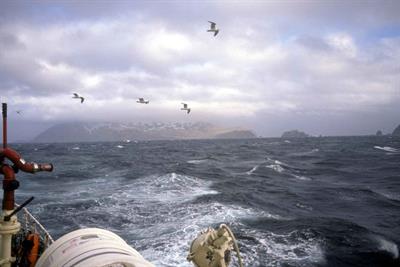
Severe storm at sea* (only for reference)
On the other hand, the winds blew 60–70 knots high. A knot is a metric of speed equal to one nautical mile per hour, or 1.852km. She also stated that the wind that blew in the sea was equivalent to the hurricane force of the wind on land. It was expected at sea because there was no land to block the winds. She also stated that they were thrilled when things broke down. The reason behind their statement was that they were able to fix it together after a lot of hard work and effort. She also said that these experiences gave them the courage to move forward. She also stated that they would remember those instances because they would overcome them with their experiences if something went wrong.
The interviewer then inquired as to how adventurous their journey was. Vartika Joshi said they saw beautiful Southern Lights from the water while crossing the Tasman Sea (situated between Australia and New Zealand). She stated that seeing the light during those months was unusual, especially from the sea. Furthermore, she added that they were utterly taken aback when they noticed the entire sky lit up in green light. They were astonished because they had not expected it.
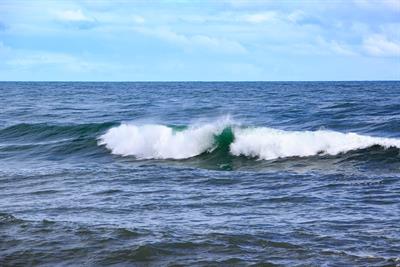
Tasman sea
Meanwhile, a variety of water species and dolphins, like their neighbours, were swimming on the side of the boat. Here the phrase "like their neighbours" means that the dolphins were moving freely without any disturbance in the way. Also, there was the fact that dolphins were friendly with human beings.
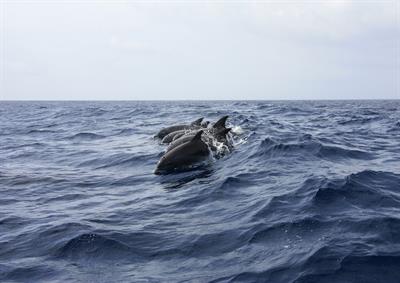
Dolphins
Vartika then mentioned seeing a dead whale in the sea. At the same time, she said that it looked like an island from a distance. It was enormous. Meanwhile, she added that they were not specialists since whenever they saw a new creature in the sea, they would instantly google it to learn more about it.
The interviewer then inquired as to how the crew spent their time at sea. After hearing this, another crew member named Swathi P stated that they engaged in numerous hobbies during the circumnavigation and began sharing photographs of items such as golgappas (panipuri) and cakes. When the weather was pleasant, they would spend their time reading novels. They also did quilling and craftwork to keep them interested. Swathi also mentioned that their team leader, Vartika Joshi, was interested in reading comic books and the Ramayana during her travels.
Meanwhile, Swathi told the interviewer about her hobbies. She mentioned that she enjoyed cooking and baking. She also stated that she enjoyed crafting and making lampshades (a cover for a lamp to soften or direct its light). She also enjoyed hearing people's compliments on the food she prepared for them. As a result, she prepared the best dishes that she would cook on land for them. She prepared with the few supplies she could get from their boat.
Vartika then mentioned seeing a dead whale in the sea. At the same time, she said that it looked like an island from a distance. It was enormous. Meanwhile, she added that they were not specialists since whenever they saw a new creature in the sea, they would instantly google it to learn more about it.
The interviewer then inquired as to how the crew spent their time at sea. After hearing this, another crew member named Swathi P stated that they engaged in numerous hobbies during the circumnavigation and began sharing photographs of items such as golgappas (panipuri) and cakes. When the weather was pleasant, they would spend their time reading novels. They also did quilling and craftwork to keep them interested. Swathi also mentioned that their team leader, Vartika Joshi, was interested in reading comic books and the Ramayana during her travels.
Meanwhile, Swathi told the interviewer about her hobbies. She mentioned that she enjoyed cooking and baking. She also stated that she enjoyed crafting and making lampshades (a cover for a lamp to soften or direct its light). She also enjoyed hearing people's compliments on the food she prepared for them. As a result, she prepared the best dishes that she would cook on land for them. She prepared with the few supplies she could get from their boat.
Vartika Joshi then stated that six was a great number, according to them. The six crew members in the sailing boat had fun with each other. They watched movies and listened to some good music. Also, she said that people wouldn't believe that the crew members in the boat had cooked well using the small kitchen area in the boat. They baked parathas, cakes, and loaves of bread, as well as halwa and rasgullas! They did it to keep them interested and prevent them from thinking the journey was too difficult to complete.

Parathas, cake and loaves of bread
Vartika told the interviewer that she and her friends had celebrated festivals at sea. When they were on land, she stated they remembered the Diwali they spent at sea. She also mentioned that they celebrated three birthdays while at sea. The first was INSV Tarini's first birthday. Others included crossing the equator, the International Date Line, and so on.
The interviewer then asked the six crew members what pushed them to live up to the standards of their country. Swathi stated that they were aware that the entire country was watching them on television and mobile devices and praying for the crew members' safety. As a result, they never wanted anyone to believe they were in danger. She also stated that others may have mistakenly assumed they were enjoying the sea voyage because they were playing and having fun. But the crew members were aware of what was going to happen next. People staying out did not know the obstacles they faced during their journey.
The major goal of their voyage was to not make people afraid by showing them their problems. As a result, they kept such things in mind and dealt with them appropriately. They had already determined that once they had travelled across the world and arrived at the land, they would show the people the difficulties they had encountered. This was created to demonstrate how the all-Indian women crew won their sea expedition and show that they did not abandon the task in the middle despite many hurdles.
The interviewer next inquired as to how they perceived this sea excursion as a woman. Vartika Joshi described it as a tremendous honour, and they couldn't think of a greater way to recognise their outstanding achievements. She also stated that the all-India women's crew was a great boost for women worldwide. However, they have learnt as sailors that the water does not distinguish between men and women. It's always gender-neutral, and they have realised that gender doesn't matter in sailing. However, she thought it was great that the all-India women's team was organised to make this expedition to boost confidence in the country and encourage more women to attempt new things, such as sailing. This lesson should motivate every woman to live her own life.
Vartika told the interviewer that she and her friends had celebrated festivals at sea. When they were on land, she stated they remembered the Diwali they spent at sea. She also mentioned that they celebrated three birthdays while at sea. The first was INSV Tarini's first birthday. Others included crossing the equator, the International Date Line, and so on.
The interviewer then asked the six crew members what pushed them to live up to the standards of their country. Swathi stated that they were aware that the entire country was watching them on television and mobile devices and praying for the crew members' safety. As a result, they never wanted anyone to believe they were in danger. She also stated that others may have mistakenly assumed they were enjoying the sea voyage because they were playing and having fun. But the crew members were aware of what was going to happen next. People staying out did not know the obstacles they faced during their journey.
The major goal of their voyage was to not make people afraid by showing them their problems. As a result, they kept such things in mind and dealt with them appropriately. They had already determined that once they had travelled across the world and arrived at the land, they would show the people the difficulties they had encountered. This was created to demonstrate how the all-Indian women crew won their sea expedition and show that they did not abandon the task in the middle despite many hurdles.
The interviewer next inquired as to how they perceived this sea excursion as a woman. Vartika Joshi described it as a tremendous honour, and they couldn't think of a greater way to recognise their outstanding achievements. She also stated that the all-India women's crew was a great boost for women worldwide. However, they have learnt as sailors that the water does not distinguish between men and women. It's always gender-neutral, and they have realised that gender doesn't matter in sailing. However, she thought it was great that the all-India women's team was organised to make this expedition to boost confidence in the country and encourage more women to attempt new things, such as sailing. This lesson should motivate every woman to live her own life.
Reference:
Admiral Sunil Lanba*: Indian Navy, GODL-India <_https3a_ gazette_notification_ogdl.pdf="" files="" default="" sites="" data.gov.in="">, via Wikimedia Commons
Indian Navy’s Six Women Crew *: Indian Navy, GODL-India <_https3a_ gazette_notification_ogdl.pdf="" files="" default="" sites="" data.gov.in="">, via Wikimedia Commons
All-women crew sails into Port Louis, Mauritius on INSV Mhadei*: Indian Navy, GODL-India <_https3a_ gazette_notification_ogdl.pdf="" files="" default="" sites="" data.gov.in="">, via Wikimedia Commons
Severe storm at sea*: Angell Bob, U.S. Fish and Wildlife Service, Public domain, via Wikimedia Commons